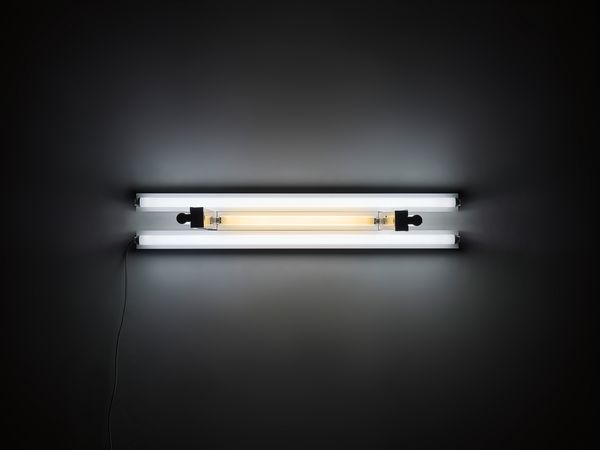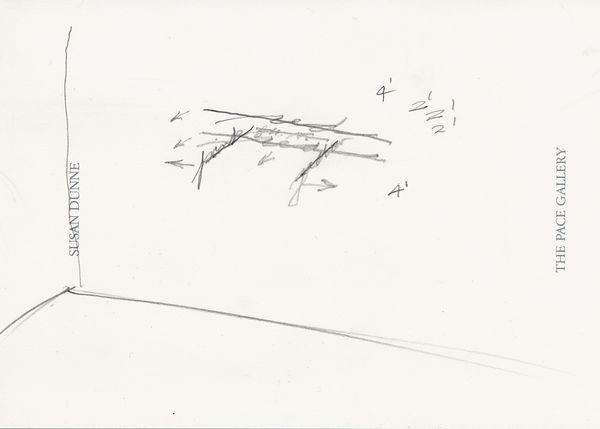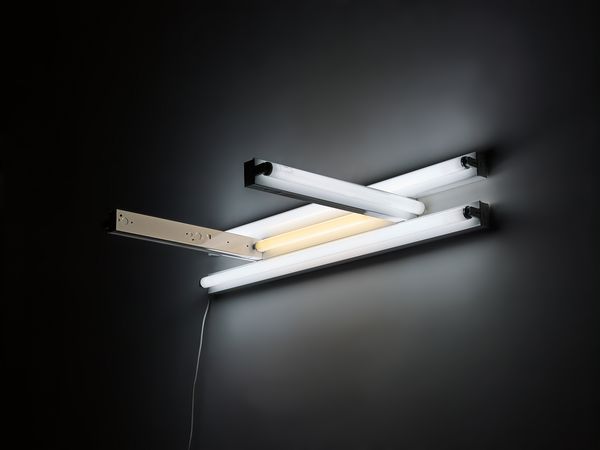Dan Flavin Untitled (to Mary Elizabeth), 1992
While walking floors as a guard in the American Museum of Natural History, I crammed my uniform pockets with notes for an electric light art. 'Flavin, we don’t pay you to be an artist,' warned the custodian in charge. I agreed and quit him. — Dan Flavin, 1965
In the late spring of 1963, Dan Flavin took a standard 8ft-long yellow fluorescent lighting unit and fixed it to the wall of his studio at a 45-degree angle, with the lowest corner of the unit’s housing just touching the floor. It was not the first time the artist had worked with light fittings, having previously attached short strip lights and small incandescent bulbs (some flashing) to simple, painted, boxy structures. These icons, as he called them, were intended as memorials, with their tragic pathos tempered by the comic and ironic kitsch quality of an electrified Catholic shrine. Each one was beautifully and laboriously crafted, whereas mounting the fluorescent strip light to the wall took almost no time or effort at all.
Dan Flavin's original sketch for the present lot, Untitled (to Mary Elizabeth)
Describing the work in his 1965 ‘autobiographical sketch’, Flavin recalled that “it seemed to sustain itself directly, dynamically, dramatically on my workroom wall – a buoyant and insistent gaseous image which, through brilliance, somewhat betrayed its physical presence into approximate invisibility.” The Diagonal of Personal Ecstasy, as this work became known, was an epiphany for Flavin – a single, simple gesture that launched the rest of his artistic career.
Dan Flavin Untitled (to Mary Elizabeth), 1992
For the following thirty-three years of his life, Flavin worked solely within a rigorously simplistic set of criteria. His pieces were created strictly from standard, mass-produced fluorescent light fittings that could be purchased from any hardware store, and he limited himself to the palette of ten commercially available colors (four types of white, pink, yellow, blue, green, red, and filtered ultra-violet) in standard 4ft, 6ft, and 8ft lengths. Despite the constraints of his choice in materials, Flavin quickly discovered that his medium was infinitely variable and by the late 1960’s, Flavin had come to master the numerous subtle, and not-so-subtle possibilities of constructing arrangements and environments in fluorescent light.
Detail from Dan Flavin's Untitled (to Mary Elizabeth), 1992
Dedicated to the nurse who cared for Dan Flavin during a period of illness in the early 1990’s, the present lot, Untitled (to Mary Elizabeth), 1992, exemplifies and distils the artist’s nuanced approach to color. Throughout his career, Flavin experimented with the chromatic and perceptual possibilities afforded by the four commercially available variations of ‘white’ fluorescent light: cool white, daylight, warm white, and soft white. Here, he uses daylight on the outer fixtures, with two protruding arms bracketing the hazy glow of the inner warm white light. The hypnotic central bar appears like the core of a shimmering sun, the edges burning into pure white that disperses gently across the wall.
Flavin’s chosen whites remain disparate, separated by their metal housings, which allow the subtle differentiation from pale amber to pale blue to seep into the gaps between the bulbs and spill over to the space in which the work inhabits. The resulting effect of elegant tranquillity, elevates the prosaic nature of the fluorescent bulbs – long familiar from numberless ordinary bathrooms and institutional corridors – to that of the elegiac. After decades of refinement, Flavin’s ‘situations’ (as he preferred to call his works) transmute the impetus of his early icons from tangible memorial, to pictorial space that is felt as much as it is seen. As with the present lot, the artist offers us an experience that is as all-encompassing as it is transformative.



